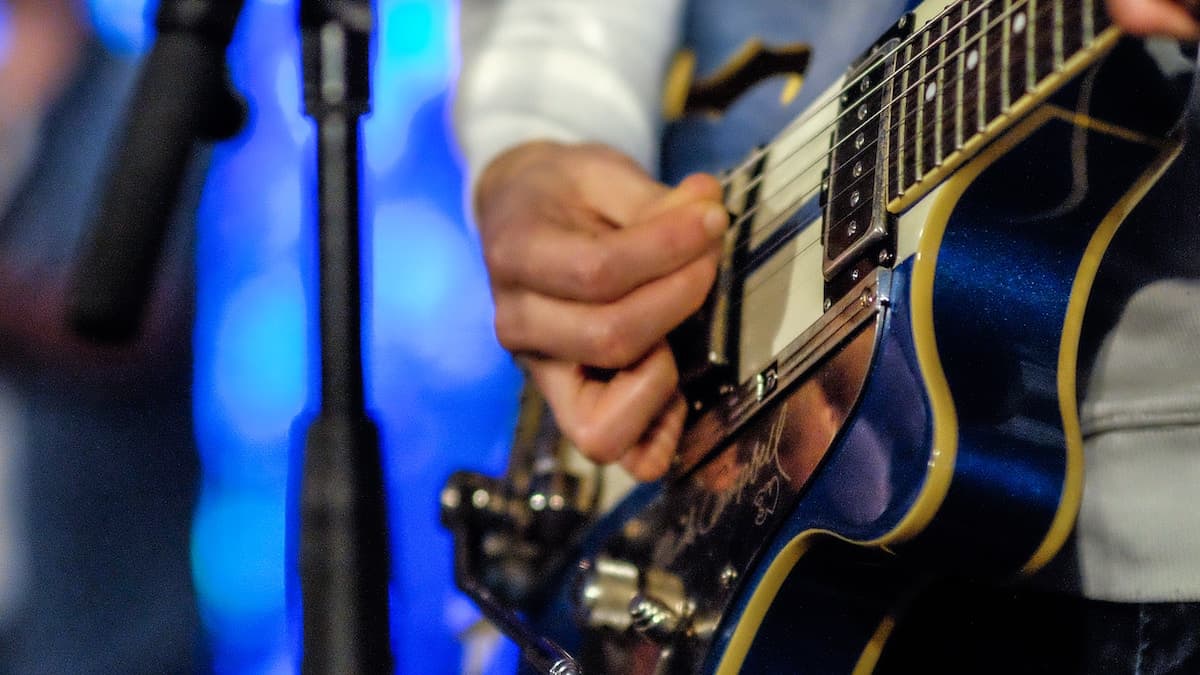Jazz Guitar Lessons
JGT Lesson: Creating Solo Guitar Intros (a la Benson)

Cool Jazzy Chords on the front end…then Killer Pentatonic and Double-Stop Blues Licks.
The intro for this original tune was inspired by guitarist George Benson. In one of his lesson videos he mentioned how he would often start playing around with a simple idea mixing lines with chords until it morphed into something special. I took that advice and decided to apply some “focused noodling” to the key of B minor. What I ended up with a few days later was the basis for a rubato solo guitar intro that set the stage for a vamp solo.
Minor Moods – Rubato Intro Highlights

1 – The opening chords shown in the first half of measure one are upper-string voicings associated with Wes Montgomery and other jazz guitarists cut from that cloth.
Note how the melody moves from E (B11) to D (Bm7) to C# (Bm9) before a single note B. The final two chords in that measure feature movement to the V chord of the key using altered voicings, an F#7#9 followed by an F#7#5. Play the latter chord using a full bar at the 2nd fret, striking the bass note before the rest of the chord.
2 – Bar two is a continuation of the previous harmony with a C#dim7, which can also be labeled an F#7b9.
As directed, hold/sustain all four tones of that chord and arpeggiate it from low to high. The last two notes of the measure are a pickup into the single-note cliches that follow the chord voicings.
3 – Speaking of GB, the 16th-note licks that take place over bars three and four are heavily-influenced by his work based on so many years of transcribing his solos.
The harmonic content in the third measure is nothing new, but the slurring via slides is what brings these “just-add-water” minor pentatonic sequences to life. Be sure to slide your 4th finger up to E, then down to D and pull-off to B (all with one pick stroke) before descending. Do likewise on beat three on the next string set. This approach can be creatively applied to any degree of that scale and in multiple positions, so experiment away.
4 – The fourth measure features a classic keyboard-oriented double-stop. It’s set up by a third finger slide into the F# on the G string.
After adding the A and B on the second string, hold the B as you plant the E with your index finger and add the rest of the story down to the A (5th string) before shifting to the traditional bar position (7th fret). At that point another double-stop is introduced with the index finger before moving down the blues scale, culminating in an index finger slide to the b3rd (D) followed by a ring finger slide back up to the root (B). Strong move with a number of potential variations.
5 – The content in the next bar may appear ridiculously simple, but appearances can be deceiving.
This is another language trick that I picked up from GB years ago. Use your index finger to quickly slide into the notes F#, E and B, all from a whole step (two frets) below. You can apply this approach almost at random to any minor pentatonic degree in a descending or ascending manner to bring the principle notes to life, and without those slides you lose the overall effect. The F#7#5 chord response in the 2nd position/fret caps off the intro and sets up the rhythm section for the upcoming vamp solo.
To hear Mark Stefani’s entire “Minor Moods” recording including the full intro and solo, click here. A complete transcription (standard notation/tab) is available in his popular Monster Guitar Solo series.
Also, check out Mark Stefani’s Rhythm & Blues Experience lesson course.
-
Jazz Guitar Lessons2 weeks ago
New JGT Guitar Lesson: Analyzing “Without A Song”
-
Jazz Guitar Lessons4 weeks ago
New JGT Guitar Lesson: Considering “Falling Grace”
-

 Artist Features1 week ago
Artist Features1 week agoNew Kurt Rosenwinkel JGT Video Podcast – July 2024
-
Artist Features2 weeks ago
JGT Talks To Seattle’s Michael Eskenazi

















